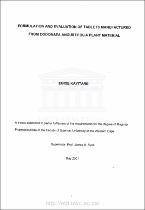| dc.description.abstract | The liquid dosage form is the most frequently used form for traditional plant medicines. However, this dosage form is associated with many problems, e.g. physicochemical instability, microbial contamination, etc. which may be solved using a solid dosage form. This study investigates the formulation and manufacture of tablets containing two types of material prepared from the leaves of Dodonaea angustifolia.
The main goal of the present study was to formulate and produce tablets containing the same amount of plant material as found in the usual dose of D. angustifolia decoction. ln addition, the suitability of using directly dried leaf powder and dried aqueous extract of the leaves, as raw material for the tablets, was compared. lt was hypothesized that tablets with acceptable physical properties and containing 80% or
more of plant material could be produced and that tablets containing dry leaf powder or dry plant extract would possess different properties.
Raw plant material in the form of dried leaf powder and dried aqueous extracts (Dry Extract 1 from wide leaf plant and Dry Extract 2from narrow leaf plant) of D. angustifolr3 were prepared and their physical characteristics determined. Based on the latter, suitable excipients were selected and formulas containing the same amount of the plant material as found in a single decoction dose of D. angustifolia were
elaborated. Thereafter, tablets containing these plant materials were manufactured using the direct compression method and the physical properties of the manufactured tablets were assessed. Results of the pre-formulation study indicated distinct differences in physical
properties between the three plant materials. The dry leaf powder had a median particle size of 20prm compared to 200pm and 3441tm for Dry Extracts 1 and 2, respectively. The dry leaf powder was significantly more soluble in ethanol than water (55.7t0.g vs. 26.1+3o/o, t-test, p=0.05), while the extracts dissolved completely but required vigorous shaking. The compressibility of the dry powder was very good
(11.910.5%), that of dry extract 2 good (15.9t2.8Yo) and that of Dry Extract 1 only passable (22.6tO.8%). All the powders showed poor flowability, but they had different potentials to pick up moisture. More importantly, the dry extracts became very cohesive and tended to dissolve in the absorbed moisture at relative humidity above 60%. The tablets containing the dry leaf powder and those containing Dry Extracts 1 and 2 required different formulas and different compression forces and displayed different physical properties. The final proportions of plant material per tablet were B5o/of or dry powder,650/o for dry extract 1 and 7Oo/of or dry extract 2. Finally, all the
final tablets had acceptable physical properties. However, the tablets containing the dry extracts showed slow disintegration (27.6 and 29.6min for Dry Extracts 1 & 2, respectively, vs. 3.1min for dry powder) and low dissolution rate (38.60/o and 6o.20/o al 45min for Extracts 1 and 2 vs. 92.7o/o for the dry powder). We conclude that the different forms of raw material prepared from the leaves of D. angustifotia have different properties, but can be formulated and manufactured into directly compressed tablets. However, the form of raw material dictates whether the tablets can contain a high proportion (80% plus) of plant material and also influences the properties of the final tablets. Comparable results can be anticipated if materials from other parts of the plant and/or from other plants are to be used. | en_US |

